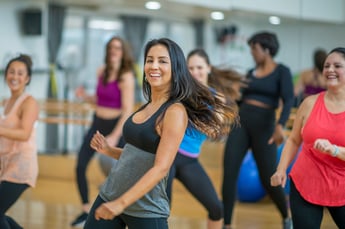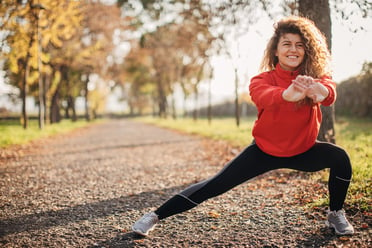Gratitude could be defined as recognizing and appreciating the “good” things in our lives, regardless of challenges that come up. Gratitude is a positive emotion that aligns with a growth mindset. Practicing this emotion can benefit our sense of well-being by reminding us of the strengths, resources, and support systems in our lives. These positive aspects of our day-to-day empower us and remind us of many gifts we have. Positive thinking and gratitude can lead to an increased sense of self-efficacy and resiliency against setbacks. In other words, positive thinking leads to positive results.
Don’t Focus on the “Bad”
Focusing on the negative aspects of the day can be an avoidable trap. Life constantly evolves with new challenges and often distracts us from the things that make us happy. If we aren’t mindful of our thought habits, we may follow a pattern of negative thinking. Negative thinking and self-criticism build up over time and can detract fromthe overall sense of happiness and fulfillment. Negativity may affect performance, may diminish morale, and may contribute long-term to the progression of disorders such as anxiety and depression. Focusing on the “bad” can decrease our perception of happiness and ultimately lead to a more fixed mindset. Appreciating the better things in life steers our thoughts and emotions towards progression and growth, rather than fixating on the negative aspects. In 1998, Martin Seligman, former president of the American Psychological Association, started the discussion on positive psychology, which has evolved over the years. The P.E.R.M.A. model of well-being was later developed from his original theories. P.E.R.M.A is an acronym for positive emotions, engagement, relationships, meaning, and achievement. This theory of positive psychology states that by acknowledging these positive aspects in our lives, we feed a deeper sense of intrinsic well-being.
Why is it important to practice gratitude?
 Feeling gratitude, or practicing it intentionally, can benefit our sense of happiness because we train our thoughts to entertain aspects of P.E.R.M.A. These thoughts serve our own greater good and connect us back to relationships, meaning, and life purpose. These thoughts are focused on things we value, regardless of the circumstances we are in.
Feeling gratitude, or practicing it intentionally, can benefit our sense of happiness because we train our thoughts to entertain aspects of P.E.R.M.A. These thoughts serve our own greater good and connect us back to relationships, meaning, and life purpose. These thoughts are focused on things we value, regardless of the circumstances we are in.
New challenges are approached with optimism as we make positive thinking habitual. Positive emotions, in a way, “strengthen” our mind by reinforcing our sense of contentment in ourselves and our surroundings. The practice of intentional positive thinking builds up mental resiliency to new challenges. Resiliency leads to approaching problems as a relative event, rather than an innate issue.
Gratitude can be a choice to acknowledge what is going well and move past the things that detract from our happiness. Gradually, positive thinking fosters a positive outlook when problem-solving, while we are actively engaged with day-to-day life.
How Gratitude can change a Fixed Mindset toward a Growth Mindset
Fixed-minded people often make the mistake of treating problems as failures or things to avoid. Growth-minded people are resilient because they treat problems as a process of ongoing development. By adopting a growth mindset, we can meet our challenges with an appreciation for where we are and embrace challenges as an anticipated part of the process. People who feel gratitude tend to be happier as they understand that life may be challenging at times, but offers many gifts to cherish.
Make Gratitude a Habit
You can start practicing gratitude in many ways by taking mindful moments throughout the day. One idea is to explore yoga, the inward journey, which was created to be a physical means of introspection and mindfulness. Try this… Before your next yoga session, try setting intentions on gratitude before your asana practice. Joining the Level 1 Yoga Class at NIFS, for example, could be a time to slow down and think about one or two things that provide meaning and happiness in your life. After 45 minutes, you may be surprised by how your thoughts are naturally more optimistic. The troubles from the day suddenly seem not so bad.
 Ready to bring more mindfulness and gratitude into your day? Join NIFS Mindful November! Follow along on our social media or stop by the service desk to discover this month’s weekly prompts and participating fitness classes as part of our Mindful Challenge.
Ready to bring more mindfulness and gratitude into your day? Join NIFS Mindful November! Follow along on our social media or stop by the service desk to discover this month’s weekly prompts and participating fitness classes as part of our Mindful Challenge.


 Movement is considered one of the best forms of preventive medicine to protect our health. In a general sense, the more we move, the healthier we tend to be. Movement isn’t restricted to structured exercises. Your body doesn’t really differentiate between walking up a flight of stairs or stepping on a stair climber. The wonderful thing about physical activity is that our bodies inherently know how to recover and adapt.
Movement is considered one of the best forms of preventive medicine to protect our health. In a general sense, the more we move, the healthier we tend to be. Movement isn’t restricted to structured exercises. Your body doesn’t really differentiate between walking up a flight of stairs or stepping on a stair climber. The wonderful thing about physical activity is that our bodies inherently know how to recover and adapt. Intuitive eating is the practice of eating in response to your body’s internal hunger and fullness cues, rather than external cues, such as environmental or social triggers that prompt eating behaviors, regardless of true hunger or fullness levels. In today’s society, it is especially difficult to eat intuitively as we are near constantly being bombarded with messaging that tells us what we should or shouldn’t eat and that labels foods as “good” or “bad.” Overtime, as the mind and body become used to ignoring hunger signals, the cues begin to fade and are more and more difficult to notice or may only be noticed when the body is in an extreme, ravenous state, which is likely to lead to overeating, which is then followed by feelings of guilt and desire to restrict based on external cues and continued ignoring of internal hunger cues. For many, the body must be reconditioned, starting with reconnecting with your biological hunger cues. Here’s how to start:
Intuitive eating is the practice of eating in response to your body’s internal hunger and fullness cues, rather than external cues, such as environmental or social triggers that prompt eating behaviors, regardless of true hunger or fullness levels. In today’s society, it is especially difficult to eat intuitively as we are near constantly being bombarded with messaging that tells us what we should or shouldn’t eat and that labels foods as “good” or “bad.” Overtime, as the mind and body become used to ignoring hunger signals, the cues begin to fade and are more and more difficult to notice or may only be noticed when the body is in an extreme, ravenous state, which is likely to lead to overeating, which is then followed by feelings of guilt and desire to restrict based on external cues and continued ignoring of internal hunger cues. For many, the body must be reconditioned, starting with reconnecting with your biological hunger cues. Here’s how to start: As the days grow shorter and temperatures drop, finding motivation to get to the gym can be tough. Between an increase in sickness, schedule changes, and chilly weather, it’s easy to lose your fitness rhythm. But sticking with your exercise routine during this time of year can actually help you feel better. Regular movement can boost your immunity, improve your mood, and increase your overall energy levels.
As the days grow shorter and temperatures drop, finding motivation to get to the gym can be tough. Between an increase in sickness, schedule changes, and chilly weather, it’s easy to lose your fitness rhythm. But sticking with your exercise routine during this time of year can actually help you feel better. Regular movement can boost your immunity, improve your mood, and increase your overall energy levels..jpg?width=254&height=169&name=GettyImages-1053000236%20(1).jpg) Tips for Staying Active
Tips for Staying Active Weightlifting and resistance training are often associated with the “gym bro” or “jock” stereotype, as if the benefits only apply to people chasing new personal records or aesthetic goals. Because of that mindset, some might find it surprising to see an older adult in the weight room. If not to build muscle or break performance barriers, what’s the point? Wouldn’t it be dangerous for someone in their 50s, 60s, or beyond to lift weights? Surely nothing good could come from someone “older” picking up heavy objects regularly, right?
Weightlifting and resistance training are often associated with the “gym bro” or “jock” stereotype, as if the benefits only apply to people chasing new personal records or aesthetic goals. Because of that mindset, some might find it surprising to see an older adult in the weight room. If not to build muscle or break performance barriers, what’s the point? Wouldn’t it be dangerous for someone in their 50s, 60s, or beyond to lift weights? Surely nothing good could come from someone “older” picking up heavy objects regularly, right? When you hear the phrase “speed training,” it’s easy to picture elite athletes—sprinters blasting off the line or pros flying down the field. But speed training isn’t reserved for them. Anyone can benefit from learning to move more efficiently, react faster, and generate more power. In fact, adding a little speed work to your weekly routine can help you feel stronger, more coordinated, and more confident in your movement—whether you’re running, lifting, or chasing your kids around the yard.
When you hear the phrase “speed training,” it’s easy to picture elite athletes—sprinters blasting off the line or pros flying down the field. But speed training isn’t reserved for them. Anyone can benefit from learning to move more efficiently, react faster, and generate more power. In fact, adding a little speed work to your weekly routine can help you feel stronger, more coordinated, and more confident in your movement—whether you’re running, lifting, or chasing your kids around the yard. You can also obtain creatine through supplements.
You can also obtain creatine through supplements. 
 In small amounts, free radicals are part of your body’s defense system. But in excess, they can damage cells and may play a role in cancer, heart disease, stroke, arthritis, vision loss, and even brain conditions like Parkinson’s or Alzheimer’s disease.
In small amounts, free radicals are part of your body’s defense system. But in excess, they can damage cells and may play a role in cancer, heart disease, stroke, arthritis, vision loss, and even brain conditions like Parkinson’s or Alzheimer’s disease. Back-to-school season is a great time for a fresh start - whether you’re a student, parent, or both! However, as your schedule changes and so does the season, there are many obstacles to getting or staying on track when it comes to your nutrition, exercise and other health-related goals. From having to wake up earlier to help the kids get ready for school to having to stay up late to complete school assignments, many factors can disrupt your usual eating, sleeping, or exercising routines. To stay ahead of these disruptions, the best strategy is to have a plan. Begin thinking about how the change to your schedule may require you to adjust your eating or exercise routines. Does the start of the school year mean you will have to get up earlier to get your workout in before you see the kids off to school? Will a late-night class or evening sports practice interfere with your usual dinner routine? If so, what adjustments need to be made to help you stay on track?
Back-to-school season is a great time for a fresh start - whether you’re a student, parent, or both! However, as your schedule changes and so does the season, there are many obstacles to getting or staying on track when it comes to your nutrition, exercise and other health-related goals. From having to wake up earlier to help the kids get ready for school to having to stay up late to complete school assignments, many factors can disrupt your usual eating, sleeping, or exercising routines. To stay ahead of these disruptions, the best strategy is to have a plan. Begin thinking about how the change to your schedule may require you to adjust your eating or exercise routines. Does the start of the school year mean you will have to get up earlier to get your workout in before you see the kids off to school? Will a late-night class or evening sports practice interfere with your usual dinner routine? If so, what adjustments need to be made to help you stay on track? imilarly to your eating routine, consider what changes must be made to maintain your exercise goals or if your exercise goals need to be reevaluated. Ask yourself: when can I realistically fit exercise/activity into my new routine/schedule? Do I need to make adjustments to the frequency or length of my activities? Are there other ways I can be active if my schedule doesn’t allow for structured exercise? For example - park the car further away from the store/office, take 5 minute breaks periodically between assignments or work tasks to get some
imilarly to your eating routine, consider what changes must be made to maintain your exercise goals or if your exercise goals need to be reevaluated. Ask yourself: when can I realistically fit exercise/activity into my new routine/schedule? Do I need to make adjustments to the frequency or length of my activities? Are there other ways I can be active if my schedule doesn’t allow for structured exercise? For example - park the car further away from the store/office, take 5 minute breaks periodically between assignments or work tasks to get some